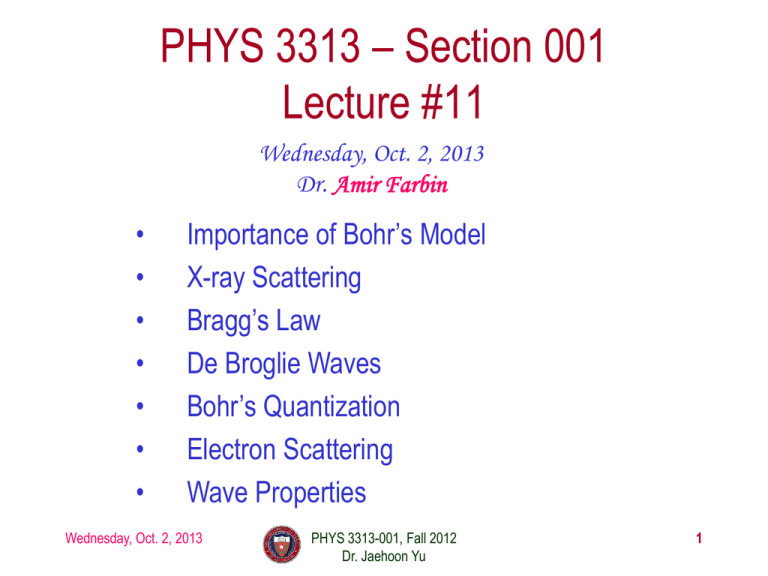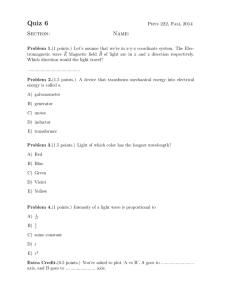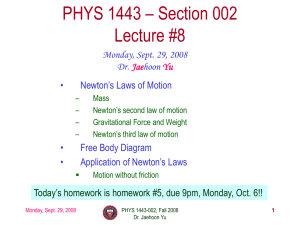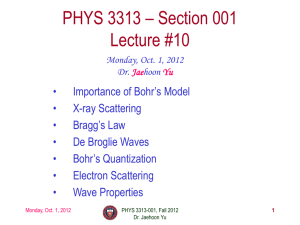Wednesday, Oct. 2, 2013
advertisement

PHYS 3313 – Section 001 Lecture #11 Wednesday, Oct. 2, 2013 Dr. Amir Farbin • • • • • • • Importance of Bohr’s Model X-ray Scattering Bragg’s Law De Broglie Waves Bohr’s Quantization Electron Scattering Wave Properties Wednesday, Oct. 2, 2013 PHYS 3313-001, Fall 2012 Dr. Jaehoon Yu 1 Announcements • Reading assignments: CH4.6 and CH4.7 • Mid-term exam – In class on Wednesday, Oct. 16 – Covers from CH1.1 through what we finish on Oct. 9 + appendices – Mid-term exam constitutes 20% of the total – Please do NOT miss the exam! You will get an F if you miss it. – Bring your own HANDWRITTEN formula sheet – one letter size sheet, front and back • No solutions for any problems • No derivations of any kind • Can have values of constants • Homework #3 – End of chapter problems on CH4: 5, 14, 17, 21, 23 and 45 – Due: Monday, Oct. 14 • Colloquium this week – 4pm, Wednesday, Oct. 2, SH101 Wednesday, Oct. 2, 2013 PHYS 3313-001, Fall 2012 Dr. Jaehoon Yu 2 Importance of Bohr’s Model • Demonstrated the need for Plank’s constant in understanding atomic structure • Assumption of quantized angular momentum which led to quantization of other quantities, r, v and E as follows 4pe 0 2 2 2 • Orbital Radius: rn = a n n = 0 2 mee • Orbital Speed: • Energy levels: Monday, Sept. 30, 2013 n 1 v= = mrn ma0 n e2 E0 En = = 2 2 8pe 0 a0 n n PHYS 3313-001, Fall 2013 Dr. Jaehoon Yu 3 Successes and Failures of the Bohr Model • The electron and hydrogen nucleus actually revolved about their mutual center of mass reduced mass correction!! • All we need is to replace me with atom’s reduced mass. me M me me = = me + M 1+ me M • The Rydberg constant for infinite nuclear mass, R∞ is replaced by R. me me e 4 1 R= R¥ = R¥ = 2 3 me 1+ me M 4p c ( 4pe 0 ) For H: RH = 1.096776 ´ 10 7 m-1 Monday, Sept. 30, 2013 PHYS 3313-001, Fall 2013 Dr. Jaehoon Yu 4 Limitations of the Bohr Model The Bohr model was a great step of the new quantum theory, but it had its limitations. 1) Works only to single-electron atoms – – Even for ions What would change? 1 1ö 2 æ 1 = Z Rç 2 - 2 ÷ The charge of the nucleus l èn n ø l u 2) Could not account for the intensities or the fine structure of the spectral lines – Fine structure is caused by the electron spin 3) Could not explain the binding of atoms into molecules Monday, Sept. 30, 2013 PHYS 3313-001, Fall 2013 Dr. Jaehoon Yu 5 Characteristic X-Ray Spectra and Atomic Number • Shells have letter names: K shell for n = 1 L shell for n = 2 • The atom is most stable in its ground state. An electron from higher shells will fill the inner-shell vacancy at lower energy. • When a transition occurs in a heavy atom, the radiation emitted is an x ray. • It has the energy E (x ray) = Eu − Eℓ. Monday, Sept. 30, 2013 PHYS 3313-001, Fall 2013 Dr. Jaehoon Yu 6 Atomic Number L shell to K shell M shell to K shell Kα x ray Kβ x ray • Atomic number Z = number of protons in the nucleus • Moseley found a relationship between the frequencies of the characteristic x ray and Z. This holds for the Kα x ray 3cR 2 fKa = ( Z -1) 4 Monday, Sept. 30, 2013 PHYS 3313-001, Fall 2013 Dr. Jaehoon Yu 7 Moseley’s Empirical Results • The x ray is produced from n = 2 to n = 1 transition. • In general, the K series of x ray wavelengths are 1ö 2æ æ1 1ö = R ( Z -1) ç 2 - 2 ÷ = R ( Z -1) ç 1- 2 ÷ è1 n ø è n ø lK 1 2 Moseley’s research clarified the importance of the electron shells for all the elements, not just for hydrogen. Monday, Sept. 30, 2013 PHYS 3313-001, Fall 2013 Dr. Jaehoon Yu 8 Atomic Excitation by Electrons • Franck and Hertz studied the phenomenon of ionization. Accelerating voltage is below 5 V electrons did not lose energy Accelerating voltage is above 5 V sudden drop in the current Monday, Sept. 30, 2013 PHYS 3313-001, Fall 2013 Dr. Jaehoon Yu 9 Atomic Excitation by Electrons • Ground state has E0 to be zero. First excited state has E1. The energy difference E1 − 0 = E1 is the excitation energy. Hg has an excitation energy of 4.88 eV in the first excited state No energy can be transferred to Hg below 4.88 eV because not enough energy is available to excite an electron to the next energy level Above 4.88 eV, the current drops because scattered electrons no longer reach the collector until the accelerating voltage reaches 9.8 eV and so on. Monday, Sept. 30, 2013 PHYS 3313-001, Fall 2013 Dr. Jaehoon Yu 10 Importance of Bohr’s Model • Demonstrated the need for Plank’s constant in understanding atomic structure • Assumption of quantized angular momentum which led to quantization of other quantities, r, v and E as follows 4pe 0 2 2 2 • Orbital Radius: rn = a n n = 0 2 mee • Orbital Speed: • Energy levels: Monday, Sept. 30, 2013 n 1 v= = mrn ma0 n e2 E0 En = = 2 2 8pe 0 a0 n n PHYS 3313-001, Fall 2013 Dr. Jaehoon Yu 11 Successes and Failures of the Bohr Model • The electron and hydrogen nucleus actually revolved about their mutual center of mass reduced mass correction!! • All we need is to replace me with atom’s reduced mass. me M me me = = me + M 1+ me M • The Rydberg constant for infinite nuclear mass, R∞ is replaced by R. me me e 4 1 R= R¥ = R¥ = 2 3 me 1+ me M 4p c ( 4pe 0 ) For H: RH = 1.096776 ´10 7 m-1 Monday, Sept. 30, 2013 PHYS 3313-001, Fall 2013 Dr. Jaehoon Yu 12 Limitations of the Bohr Model The Bohr model was a great step of the new quantum theory, but it had its limitations. 1) Works only to single-electron atoms – – Even for ions What would change? 1 1ö 2 æ 1 The charge of the nucleus l = Z R çè n2 - n2 ÷ø l u 2) Could not account for the intensities or the fine structure of the spectral lines – – Fine structure is caused by the electron spin When a magnetic field is applied, spectral lines split 3) Could not explain the binding of atoms into molecules Monday, Sept. 30, 2013 PHYS 3313-001, Fall 2013 Dr. Jaehoon Yu 13 X-Ray Scattering Max von Laue suggested that if x rays were a form of electromagnetic radiation, interference effects should be observed. (Wave property!!) Crystals act as three-dimensional gratings, scattering the waves and producing observable interference effects. Monday, Sept. 30, 2013 PHYS 3313-001, Fall 2013 Dr. Jaehoon Yu 14 Bragg’s Law William Lawrence Bragg interpreted the x-ray scattering as the reflection of the incident x-ray beam from a unique set of planes of atoms within the crystal. There are two conditions for constructive interference of the scattered x rays: 1) The angle of incidence must equal the angle of reflection of the outgoing wave. (total reflection) 2) The difference in path lengths between two rays must be an integral number of wavelengths. Bragg’s Law: • nλ = 2d sin θ • (n = integer) Monday, Sept. 30, 2013 PHYS 3313-001, Fall 2013 Dr. Jaehoon Yu 15 The Bragg Spectrometer A Bragg spectrometer scatters x rays from several crystals. The intensity of the diffracted beam is determined as a function of scattering angle by rotating the crystal and the detector. When a beam of x rays passes through the powdered crystal, the dots become a series of rings due to random arrangement. Monday, Sept. 30, 2013 PHYS 3313-001, Fall 2013 Dr. Jaehoon Yu 16 Ex 5.1: Bragg’s Law X rays scattered from rock salt (NaCl) are observed to have an intense maximum at an angle of 20o from the incident direction. Assuming n=1 (from the intensity), what must be the wavelength of the incident radiation? • • • • Bragg’s law: nλ = 2d sin θ What do we need to know to use this? The lattice spacing d! We know n=1 and 2θ=20o. We use the density of NaCl to find out what d is. N molecules N A r NaCl ( 6.02 ´10 23 molecules mol ) × ( 2.16 g cm 3 ) = = = V M 58.5 g mol 22 atoms 28 atoms 22 molecules = 4.45 ´10 = 2.22 ´10 = 4.45 ´10 3 3 cm m3 cm 1 1 28 atoms d= = 0.282nm = 4.45 ´10 28 3 3 3 4.45 ´10 d m l = 2d sinq = 2 ×0.282 ×sin10o = 0.098nm Monday, Sept. 30, 2013 PHYS 3313-001, Fall 2013 Dr. Jaehoon Yu 17 De Broglie Waves • Prince Louis V. de Broglie suggested that mass particles should have wave properties similar to electromagnetic radiation many experiments supported this! • Thus the wavelength of a matter wave is called the de Broglie wavelength: h l= p • Since for a photon, E = pc and E = hf, the energy can be written as E = hf = pc = pl f Monday, Sept. 30, 2013 PHYS 3313-001, Fall 2013 Dr. Jaehoon Yu 18 Bohr’s Quantization Condition • One of Bohr’s assumptions concerning his hydrogen atom model was that the angular momentum of the electron-nucleus system in a stationary state is an integral multiple of h/2π. • The electron is a standing wave in an orbit around the proton. This standing wave will have nodes and be an integral number of wavelengths. h 2p r = nl = n p • The angular momentum becomes: nh h p=n L = rp = =n 2p p 2p Monday, Sept. 30, 2013 PHYS 3313-001, Fall 2013 Dr. Jaehoon Yu 19 Ex 5.2: De Broglie Wavelength Calculate the De Broglie wavelength of (a) a tennis ball of mass 57g traveling 25m/s (about 56mph) and (b) an electron with kinetic energy 50eV. • • What is the formula for De Broglie Wavelength? (a) for a tennis ball, m=0.057kg. h l= p h 6.63 ´10 -34 l= = = 4.7 ´10 -34 m p 0.057 × 25 • (b) for electron with 50eV KE, since KE is small, we can use non-relativistic expression of electron momentum! h h l= = = p 2me K • • hc 2mec 2 K = 1240eV × nm = 0.17nm 2 × 0.511MeV × 50eV What are the wavelengths of you running at the speed of 2m/s? What about your car of 2 metric tons at 100mph? How about the proton with 14TeV kinetic energy? What is the momentum of the photon from a green laser? Monday, Sept. 30, 2013 PHYS 3313-001, Fall 2013 Dr. Jaehoon Yu 20 Electron Scattering Davisson and Germer experimentally observed that electrons were diffracted much like x rays in nickel crystals. direct proof of De Broglie wave! Dsinf l= n George P. Thomson (1892–1975), son of J. J. Thomson, reported seeing the effects of electron diffraction in transmission experiments. The first target was celluloid, and soon after that gold, aluminum, and platinum were used. The randomly oriented polycrystalline sample of SnO2 produces rings as shown in the figure at right. Monday, Sept. 30, 2013 PHYS 3313-001, Fall 2013 Dr. Jaehoon Yu 21 • Photons, which we thought were waves, act particle like (eg Photoelectric effect or Compton Scattering) • Electrons, which we thought were particles, act particle like (eg electron scattering) • De Broglie: All matter has intrinsic wavelength. – Wave length inversely proportional to momentum – The more massive… the smaller the wavelength… the harder to observe the wavelike properties – So while photons appear mostly wavelike, electrons (next lightest particle!) appear mostly particle like. • How can we reconcile the wave/particle views? Monday, Sept. 30, 2013 PHYS 3313-001, Fall 2013 Dr. Jaehoon Yu 22 Wave Motion De Broglie matter waves suggest a further description. The displacement of a wave is é 2p ù Y ( x,t ) = Asin ê ( x - vt ) ú ël û This is a solution to the wave equation ¶2 Y 1 ¶2 Y = 2 2 2 ¶x v ¶t Define the wave number k and the angular frequency as: 2p 2p kº l and w = T l = vT The wave function is now: Y ( x,t ) = Asin [ kx - w t ] Monday, Sept. 30, 2013 PHYS 3313-001, Fall 2013 Dr. Jaehoon Yu 23 Wave Properties • The phase velocity is the velocity of a point on the wave that has a given phase (for example, the crest) and is given by l l 2p w v ph = = = T 2p T k • A phase constant Φ shifts the wave: Y ( x,t ) = Asin[ kx - w t + f. ] = Acos[ kx - w t ] (When =/2) Monday, Sept. 30, 2013 PHYS 3313-001, Fall 2013 Dr. Jaehoon Yu 24 Principle of Superposition • When two or more waves traverse the same region, they act independently of each other. • Combining two waves yields: Dw ö æ Dk Y x,t + Y x,t = ) 2Acos ç x - t ÷ cos ( kav x - w avt ) Y ( x,t ) = 1 ( ) 2( è 2 2 ø • The combined wave oscillates within an envelope that denotes the maximum displacement of the combined waves. • When combining many waves with different amplitudes and frequencies, a pulse, or wave packet, can be formed, which can move at a group velocity: ugr = Dw Dk Monday, Sept. 30, 2013 PHYS 3313-001, Fall 2013 Dr. Jaehoon Yu 25 Fourier Series • Adding 2 waves isn’t localized in space… but adding lots of waves can be. • The sum of many waves that form a wave packet is called a Fourier series: Y ( x,t ) = å Ai sin [ ki x - w i t ] i • Summing an infinite number of waves yields the Fourier integral: Y ( x,t ) = ò A ( k ) cos [ kx - w t ]dk Monday, Sept. 30, 2013 PHYS 3313-001, Fall 2013 Dr. Jaehoon Yu 26 Wave Packet Envelope • The superposition of two waves yields a wave number and angular frequency of the wave packet envelope. Dk Dw x2 2 • The range of wave numbers and angular frequencies that produce the wave packet have the following relations: DkDx = 2p DwDt = 2p • A Gaussian wave packet has similar relations: 1 DkDx = 2 1 DwDt = 2 • The localization of the wave packet over a small region to describe a particle requires a large range of wave numbers. Conversely, a small range of wave numbers cannot produce a wave packet localized within a small distance. Monday, Sept. 30, 2013 PHYS 3313-001, Fall 2013 Dr. Jaehoon Yu 27 Gaussian Function A Gaussian wave packet describes the envelope of a pulse 2 2 Dk x wave. Y ( x,0 ) = Y ( x ) = Ae cos ( k x ) 0 dw The group velocity is ugr = dk Monday, Sept. 30, 2013 PHYS 3313-001, Fall 2013 Dr. Jaehoon Yu 28




